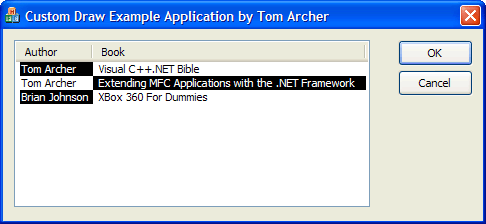如何向窗口发送消息
CWnd类的SendMessage和PostMessage成员函数.
第一步:在头文件中自定义消息,如:
[cpp]
#define WM_USER_MSG (WM_USER +100)
第二步:通过类向导点击Message选项卡,添加自定义消息WM_USER_MSG.
第三步:实现自定义消息的响应函数.
第四步:发送消息.
发送消息有两种方式.
1 同步发送(SendMessage)
[plain]
LRESULT SendMessage(
UINT message,
WPARAM wParam = 0,
LPARAM lParam = 0
);
message:消息ID.
wParam:参数1
lParam:参数2
返回值:消息函数函数的处理结果.
这里同步发送是指发送消息并处理完后才返回.如:
http://msdn.microsoft.com/en-US/library/t64sseb3(v=vs.80)
[cpp]
// In a dialog-based app, if you add a minimize button to your
// dialog, you will need the code below to draw the icon.
void CMyDlg::OnPaint()
{
if (IsIconic())
{
CPaintDC dc(this); // device context for painting
SendMessage(WM_ICONERASEBKGND, (WPARAM) dc.GetSafeHdc(), 0);
// Center icon in client rectangle
int cxIcon = GetSystemMetrics(SM_CXICON);
int cyIcon = GetSystemMetrics(SM_CYICON);
CRect rect;
GetClientRect(&rect);
int x = (rect.Width() - cxIcon + 1) / 2;
int y = (rect.Height() - cyIcon + 1) / 2;
// Draw the icon represented by handle m_hIcon
dc.DrawIcon(x, y, m_hIcon);
}
else
{
CDialog::OnPaint();
}
}
MSDN中对SendMessage解说如下:
[plain]
The SendMessage member function calls the window procedure directly and does not return until that window procedure has processed the message
即只有当消息处理函数处理完消息后这个"发送"操作才会返回结束.
2 异步方式(PostMessage)
http://msdn.microsoft.com/en-US/library/9tdesxec(v=vs.80)
[plain] view plaincopy
BOOL PostMessage(
UINT message,
WPARAM wParam = 0,
LPARAM lParam = 0
);
参数说明与SendMessage一样,不过返回值不同,这个接口的返回是将消息发送到消息队列可立即返回,并不等待消息处理完后返回.
发送消息也可以通过Windos API函数:
[cpp]
LRESULT WINAPI SendMessage(
_In_ HWND hWnd,
_In_ UINT Msg,
_In_ WPARAM wParam,
_In_ LPARAM lParam
);
hWnd为要发送的窗口句柄.
[cpp]
LRESULT Res=::SendMessage(HWND hWnd, UINT Msg, WPARAM wParam, LPARAM lParam);
相对应的异步发送接口为:
[cpp]
BOOL WINAPI PostMessage(
_In_opt_ HWND hWnd,
_In_ UINT Msg,
_In_ WPARAM wParam,
_In_ LPARAM lParam
);
使用与::SendMessage一样.




